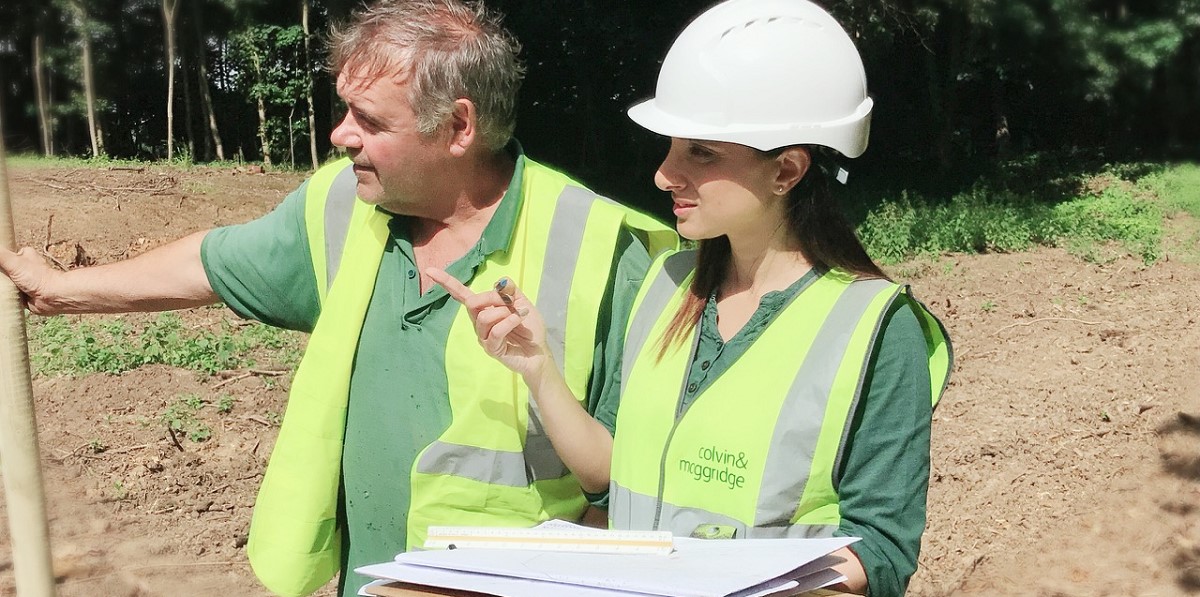Home>diy>Planning & Engineering>How To File A Complaint Against A Landscape Architect


Planning & Engineering
How To File A Complaint Against A Landscape Architect
Modified: August 16, 2024
Learn how to file a complaint against a landscape architect specializing in planning-engineering. Take action to address any unsatisfactory work or professional misconduct.
(Many of the links in this article redirect to a specific reviewed product. Your purchase of these products through affiliate links helps to generate commission for Storables.com, at no extra cost. Learn more)
Introduction
Have you recently had a negative experience with a landscape architect? Are you unsatisfied with the quality of their work or their level of professionalism? If so, it may be necessary to file a complaint against the landscape architect to ensure that your concerns are addressed and resolved.
Filing a complaint against a landscape architect is a serious matter that should not be taken lightly. However, it is an essential step in holding the architect accountable for their actions and providing you with the opportunity to seek a resolution.
In this article, we will guide you through the process of filing a complaint against a landscape architect, from understanding the complaint process to gathering the necessary information and finally submitting the complaint. We will also provide tips on how to follow up on your complaint and work towards achieving a satisfactory resolution.
Whether it’s a breach of contract, substandard workmanship, unprofessional behavior, or any other issue that has caused you distress, filing a complaint allows you to voice your concerns and seek appropriate measures to address them.
Remember, a well-documented and thoughtfully drafted complaint carries a stronger weight and is more likely to be taken seriously by the relevant authorities. So, let’s dive into the process of filing a complaint against a landscape architect and ensure that your concerns are heard.
Before we proceed, it is important to note that the specific complaint process may vary depending on your jurisdiction or the professional body governing landscape architects in your area. It is prudent to familiarize yourself with the relevant regulations and procedures applicable to your specific situation.
Now, let’s move on to understanding the complaint process and what steps you need to follow.
Key Takeaways:
- Hold landscape architects accountable by understanding the complaint process, gathering evidence, and submitting a well-drafted complaint to the appropriate authority for a fair evaluation and resolution.
- Stay proactive and persistent in following up on your complaint, cooperating with investigations, and exploring alternative dispute resolution methods to seek a satisfactory resolution and uphold professional standards in the industry.
Understanding the Complaint Process
Before proceeding with filing a complaint against a landscape architect, it is crucial to have a clear understanding of the complaint process. By familiarizing yourself with the steps involved, you can navigate the process more effectively and increase the chances of a successful outcome.
1. Research the governing body: Start by identifying the governing body or professional association that oversees landscape architects in your area. This could be a state regulatory board, a professional association, or any other relevant authority responsible for licensing and regulating landscape architects. Understanding their role and responsibilities will help you approach the complaint process appropriately.
2. Review the complaint guidelines: Once you have identified the governing body, visit their website or contact their office to obtain the complaint guidelines. These guidelines will provide you with valuable information regarding the process, required documentation, and any specific requirements for filing a complaint. Familiarize yourself with these guidelines to ensure that you meet all the necessary criteria.
3. Determine the grounds for your complaint: Before proceeding, it is essential to identify the grounds for your complaint. Evaluate the issues you have encountered with the landscape architect and determine if they fall under any specific violation or breach. This could include negligence, incompetence, failure to adhere to professional standards, or any other specific concern. Having a clear understanding of the grounds for your complaint will help you articulate your concerns more effectively.
4. Assess the potential outcomes: While it is important to seek a resolution, it is equally vital to have realistic expectations regarding the potential outcomes of your complaint. Understand the authority’s power to investigate and take disciplinary actions, and be aware of the possible consequences the landscape architect may face if your complaint is substantiated. This knowledge will help you assess the feasibility and potential impact of filing a complaint.
5. Determine the timeframe: Complaint processes often have specific timeframes within which complaints must be filed. Ensure that you are aware of any deadlines and adhere to them to avoid any delays or possible dismissal of your complaint. Timeliness is key when it comes to filing a complaint.
By understanding the complaint process, you can proceed with confidence and ensure that you are well-prepared to navigate each step. In the next section, we will discuss the importance of gathering information before filing your complaint.
Gathering Information
Before you can move forward with filing a complaint against a landscape architect, it is essential to gather all the necessary information to support your case. Collecting relevant documentation and evidence will strengthen your complaint and increase its chances of being taken seriously. Here are some important steps to follow when gathering information:
1. Documentation: Start by gathering any documentation related to your interactions with the landscape architect. This includes contracts, invoices, emails, photographs, and any other written or digital correspondence. These documents will serve as evidence of the agreed-upon scope of work, timelines, and any deviations or failures by the landscape architect.
2. Communication Records: Compile a record of all conversations and interactions you have had with the landscape architect. This could include phone calls, meetings, and even text messages. Be sure to note down the date, time, and nature of each communication. This record will support your claims and provide a timeline of events.
3. Witnesses: If there were any witnesses to problematic interactions or instances of substandard work by the landscape architect, it is important to contact them and gather their statements. Witness testimonies can be highly influential in supporting your complaint.
4. Professional Opinions: If you have concerns about the quality of the work performed by the landscape architect, consider seeking opinions from other reputable professionals in the field. Request their assessment of the work completed and obtain written statements or reports to support your case.
5. Research Legal and Regulatory Standards: Familiarize yourself with the legal and regulatory standards that landscape architects are required to adhere to in your jurisdiction. This knowledge will help you identify any violations or failures on the part of the landscape architect, strengthening your complaint.
Remember to organize all the gathered information in a logical and easy-to-follow format. This will make it easier for you to reference specific pieces of evidence when drafting your complaint.
Once you have gathered all the necessary information, you are ready to move on to the next step: drafting your complaint. We will discuss this process in detail in the following section.
Drafting Your Complaint
When it comes to filing a complaint against a landscape architect, the way you present your concerns can greatly impact the outcome. A well-drafted complaint is clear, concise, and provides sufficient detail to support your allegations. Here are some important tips to keep in mind when drafting your complaint:
1. Use a formal tone: Your complaint should be written in a formal tone to maintain professionalism. Avoid using emotional language or derogatory remarks about the landscape architect. Stick to a factual and objective approach to ensure that your complaint is taken seriously.
2. Clearly state the issue: Begin your complaint by clearly stating the main issue or concern you have with the landscape architect. Be specific and provide details about what went wrong, how it impacted you, and why it is a violation of professional standards.
3. Provide supporting evidence: In the body of your complaint, present the supporting evidence you have gathered during the information gathering phase. Reference specific documents, communication records, witness statements, and professional opinions to substantiate your claims.
4. Be organized and concise: Structure your complaint in a logical manner, organizing your points chronologically or thematically. Keep your paragraphs concise and focused on a single point or incident. This will make it easier for the reader to understand and follow your argument.
5. Reference applicable regulations or standards: If there are specific regulations or professional standards that the landscape architect has violated, make sure to reference them in your complaint. This demonstrates that you have a clear understanding of the rules and expectations within the industry.
6. Request a specific resolution: Clearly state what you are seeking as a resolution to your complaint. Whether it is a refund, corrective action, or other forms of compensation, clearly articulate what you believe would be fair and appropriate to rectify the situation.
7. Proofread and revise: Before finalizing your complaint, carefully proofread it for grammar and spelling errors. Make sure that your complaint is organized, coherent, and effectively communicates your concerns. If possible, have someone else review it for clarity and accuracy.
By taking the time to draft a comprehensive and well-structured complaint, you increase the chances of it being taken seriously and addressed promptly. Once your complaint is finalized, you are ready to move on to the next step: submitting your complaint for review.
Before filing a complaint against a landscape architect, gather all relevant documentation and evidence to support your claim. This may include contracts, emails, photos, and any other relevant communication.
Submitting Your Complaint
After drafting a well-crafted complaint against a landscape architect, the next step is to submit it to the appropriate authority or governing body. The process for submitting a complaint may vary depending on your jurisdiction and the specific regulations in place. Here are some general steps to follow when submitting your complaint:
1. Review the submission requirements: Before submitting your complaint, carefully review the submission requirements outlined by the governing body or professional association. Ensure that you have included all the necessary documentation and information as requested.
2. Prepare copies: Make copies of your complaint and all supporting documents. Keep one set of copies for your records, and send the original complaint along with the copies to the designated address or email provided by the authority. If you choose to submit your complaint electronically, ensure that all documents are properly scanned and saved in the required file format.
3. Follow submission instructions: Pay close attention to any specific instructions or procedures outlined by the authority. This may include filling out specific forms, including a cover letter, or adhering to a prescribed format for your complaint. Failure to follow these instructions may result in delays or dismissal of your complaint.
4. Keep evidence for yourself: It is prudent to retain a complete set of copies of all documents and evidence related to your complaint for your own reference. This will serve as a backup and allow you to easily retrieve information if needed throughout the complaint process.
5. Request confirmation or receipt: If possible, request a confirmation or receipt of your complaint submission. This ensures that your complaint has been received and officially acknowledged. Keep this confirmation for your records.
Remember, the submission process is a critical step in the complaint process, and attention to detail is key. By following the required procedures and submitting all necessary documentation, you are setting the stage for a thorough review of your complaint. Once your complaint is submitted, it’s important to stay proactive and follow up on its progress.
In the next section, we will discuss the importance of follow-up and resolution in the complaint process.
Read more: How To Choose A Landscape Architect
Follow-up and Resolution
Once you have submitted your complaint against a landscape architect, it is important to follow up on its progress and work towards achieving a resolution. While the specific timeline and process may vary, here are some general guidelines to help you navigate the follow-up and resolution stage:
1. Confirm receipt of your complaint: If you have not received a confirmation or acknowledgment of your complaint within a reasonable timeframe, it is advisable to follow up with the relevant authority. This ensures that your complaint has been properly received and is being processed.
2. Keep records of communication: Maintain a detailed record of any communication you have with the governing body or professional association regarding your complaint. This includes emails, letters, phone calls, and any documentation they provide in response to your complaint.
3. Cooperate with the investigation: If your complaint moves forward with an investigation, it is crucial to cooperate fully. Provide any additional information or evidence requested by the investigating body promptly and accurately. This demonstrates your commitment to resolving the issue at hand.
4. Seek updates: Regularly inquire about the progress of your complaint. Contact the governing body or professional association to ensure that your complaint is progressing according to the established timeline. It is important to have realistic expectations regarding the time it takes to investigate and resolve a complaint.
5. Consider mediation or alternative dispute resolution: In some cases, it may be beneficial to explore mediation or alternative dispute resolution methods to reach a resolution. This can save time and avoid lengthy legal proceedings. Consult with the governing body or seek legal advice to determine if these alternative options are available for your specific situation.
6. Stay informed: Familiarize yourself with the regulations or procedures governing the complaint resolution process. Understand the potential outcomes and consequences for the landscape architect if your complaint is substantiated. This knowledge will help you assess the progress and potential resolution of your complaint.
Patience and persistence are key during the follow-up and resolution stage. While it may take time to navigate through the process, staying proactive and engaged will demonstrate your commitment to seeking a fair resolution to your concerns. In the final section, we will conclude our discussion on filing a complaint against a landscape architect.
Conclusion
Filing a complaint against a landscape architect is an important step in holding them accountable for their actions and seeking a resolution to your concerns. By understanding the complaint process, gathering relevant information, drafting a comprehensive complaint, and submitting it to the appropriate authority, you are taking the necessary steps to address the issues you have encountered.
Throughout the process, it is important to maintain professionalism, provide clear and concise details, and follow all the guidelines and procedures set by the governing body or professional association. By doing so, you increase the chances of your complaint being taken seriously and receiving a fair evaluation.
Remember to remain proactive and stay informed about the progress of your complaint. Follow up regularly with the relevant authority and cooperate fully with any investigations or requests for additional information. Additionally, consider exploring mediation or alternative dispute resolution methods to facilitate a satisfactory resolution.
While the complaint process may take time, your commitment to seeking a resolution will make a difference. Ultimately, filing a complaint against a landscape architect not only provides you with a platform to voice your concerns but also contributes to maintaining professional standards in the field.
If you are unsure about the specific regulations or procedures governing complaints against landscape architects in your jurisdiction, it is advisable to seek legal advice or consult the relevant authority for guidance tailored to your situation.
In conclusion, by navigating the complaint process and actively participating, you can work towards resolving your concerns and ensure that landscape architects uphold the standards and professionalism expected in their industry.
Frequently Asked Questions about How To File A Complaint Against A Landscape Architect
Was this page helpful?
At Storables.com, we guarantee accurate and reliable information. Our content, validated by Expert Board Contributors, is crafted following stringent Editorial Policies. We're committed to providing you with well-researched, expert-backed insights for all your informational needs.















0 thoughts on “How To File A Complaint Against A Landscape Architect”